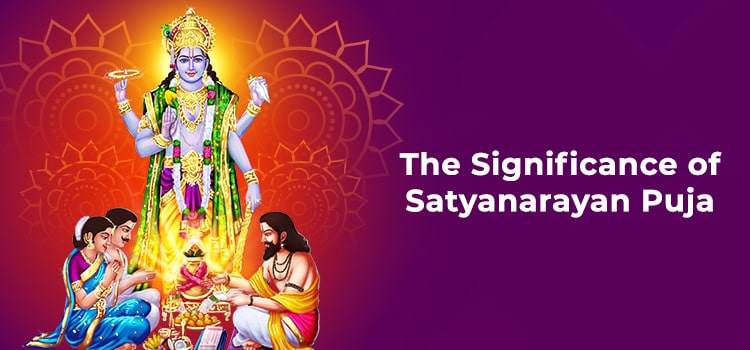The Significance of Satyanarayan Pooja
Satyanarayanã Pooja is a religious ritual that is dedicated to Vishnu. It is described in the Skanda Purana.
During the Pooja, people recite the Satyanarayana Katha (story). It explains the material and spiritual benefits of the Pooja and narrates how Vishnu or Narayana vows to come to the help of his devotees during Kali Yuga (the last of the four ages in Hindu cosmology), especially those who perform or participate in the ritual. The Katha says that performing the Pooja is a pledge to God and describes what happens to those who do not complete the Pooja or forget their pledge.
According to Skanda Purana, Vishnu taught Satya Narayana vratam to Sage Narada when the sage asked Vishnu how human beings can overcome problems in the terrible age of Kali Yuga. The Pooja is supposedly an easy solution to the problems of human beings in this Yuga. It can bring spiritual progress as well as material success.
Satyanarayan Pooja is one of the most popular Poojas among Hindus. Hindus have been performing it since time immemorial. ‘Satyanarayan’ combines two words, ‘Satya’ and ‘Narayan’. ‘Satya’ means ‘truth,’ while ‘Narayan’ means ‘the highest being’. So, Satyanarayan is the highest being who embodies truth, and Satyanarayan Pooja is the worship of Vishnu or the eternal embodiment of truth.

Significance of Satyanarayan Pooja
Hindus believe that worshipping Vishnu as Satyanarayan can help one overcome all problems and difficulties. Those who worship Vishnu (the God of truth) with great devotion and faith will be true to themselves and others. To overcome the problems caused by actions in this life or the previous life, one should worship truth. The Pooja is very popular due to its simple rituals, which people can perform at any time of the day and by anyone, irrespective of age, gender, and marital status. Purnima and Ekadashi are the most auspicious days to perform the Pooja.
People perform the Pooja to gain the blessings of health, wealth, prosperity, and relief from sickness and troubles. It is also performed for success in career or business and also during special occasions like marriages, Griha Pravesham, naming of children, etc.
Satyanarayan Puja has great significance in Hindu traditions due to its spiritual and material benefits. Kings, Merchants, Traders, and Businessmen have performed the Pooja to appease Vishnu and to boost their finances. The Pooja is especially popular in Maharashtra, Andhra Pradesh, Gujarat, Odisha, Tamilnadu, and Karnataka.
Pooja Samagri
· Pooja Thali: A decorative plate for holding the Pooja items, like flowers, incense sticks, aarti lamps, and Prasad.
· Flowers: Offering fresh flowers to God represents purity, devotion, and reverence.
· Incense Sticks and Dhoop: Lighting incense and dhoop creates a fragrant and spiritual atmosphere and purifies the surroundings.
· Sweets and Fruits: These comprise the Prasad offered to God. It is distributed among devotees after the Pooja.
· Pooja Coins: These are used for tikka (sacred mark) and are auspicious.
Satyanarayana Pooja Procedure
· The rituals are quite easy. The Pooja may last two to three hours. Usually, it takes place in the evening. Devotees also observe the Satyanarayana Vrata on the day of the Pooja.
· The Pooja starts with Acamanah (self-purification), Pranayama (to enhance spirituality inside the body), and Sankalp (vow to complete the ritual).
· Devotees perform the Ganapati Pooja or Homam first to appease Ganapati so that the Pooja takes place without any obstacles.
· Then come Deepa Sthapana (lighting lamps), Bhumi Prarthana (paying homage to Mother Earth), Kalasa Sthapana, Kalasa Pooja, Varuna Pooja, and the Aatmashuddhi.
· The other Poojas that people perform as part of the ritual are Navagraha Pooja, Tulsi Pooja, Panchamritha Pooja, Dvarapalaka Pooja, Digpalika Pooja, and Panchamritha Abhishekam. Many Suktas and Slokas are recited, and Lakshmi Pooja is performed.
· The Satyanarayan Katha (story) is recited. Five chapters that depict the miracles performed by Satyanarayan are read out. This holy scripture narrates the story of Satyanarayan and is the core of the Pooja.
· The Ashtottara Pooja (recital of 108 names of Vishnu), Naivedyam, Tambulam, Dakshina, Aarti, Pradakshina, Namaskara, Aatma Samarpana and lastly, Samarpanam mark the end of the rituals.
Who Should Perform Satyanarayana Pooja?
· Someone who is beginning a new venture or a new business can perform this Pooja. It is also performed during marriages, birthday celebrations, Griha Pravesh, and when beginning higher studies.
· Parents perform the Pooja at their infant’s naming ceremony.
· You can also perform the Pooja if someone in the family is sick.
Satyanarayana Pooja Benefits
· One can gain peace and prosperity in life. There will be overall happiness and family bliss.
· It clears the negativity around us and bestows a positive approach towards life.
· The Pooja also grants good health.
When to Perform Satyanarayana Pooja?
Chitra Pournami day (in April) is very auspicious for performing the Satyanarayana Pooja. The Pooja can be performed at any time on Purnima or full moon day. But it should not be performed on a New Moon day.
Benefits of Satyanarayan Pooja
- It helps to calm the mind and reduce worries. It induces positivity. - All obstacles and problems may vanish from one’s life, and one can achieve success in one’s endeavors. - It creates a protective shield around us and protects us from the evil intentions of others. - It absolves our past life and present life sins and helps us to become righteous and enlightened beings. - The Pooja’s ultimate benefit is that it helps one to attain Moksha or salvation.




















